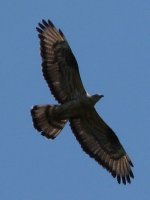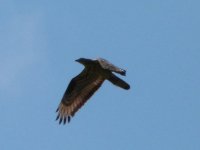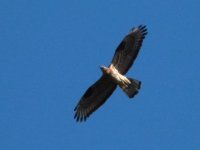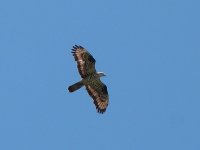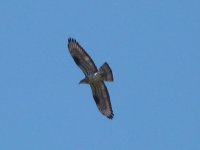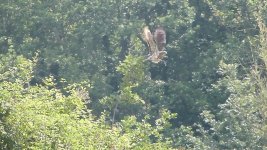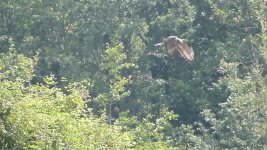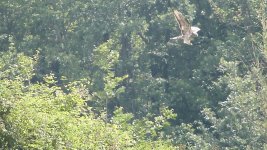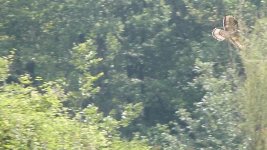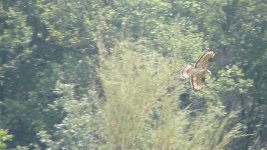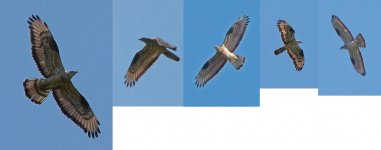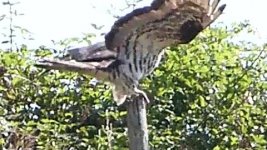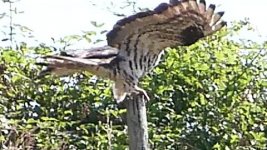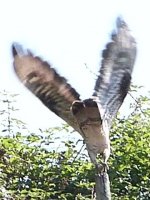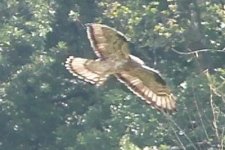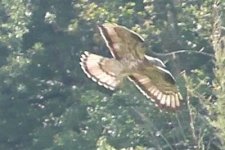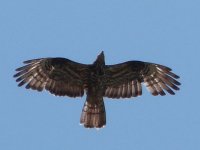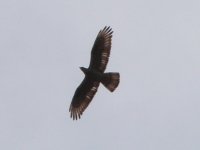I thought to wrap up this thread, it feels like the Honey season is well over in our valley. Since 10th August, I have neither seen nor heard a single HB. On that morning, I heard a poignant call, repeated over and over, coming from the south ridge woods which I had concluded was the most likely area of the nesting. Probably that's where they've been in previous years. It is within easy reach of all the spots where I have seen them, the wood over which the male often called, the posts in the field immediately west of the house where the female has perched, the wasp hill slope which rises from the house where both male and female have so often come. a little stream runs along the bottom of the south ridge, I've seen the male hunting on its banks. well, this year there is no water in the stream, the tracks are dust, the slopes parched, the trees already dropping their leaves from want of rain.
Overall this summer, most unusually, the female was seen more often than the male, coming in low from the south to the wasp slope, and in 5-10 minutes flying out again. On 20th July, I caught glimpses of 3 visits by one or the other to Wasp Hill; the third time, I saw the female came off the hill carrying something in her claws. There were calls from above, and there he was at some height, calling repeatedly. She answered and rose up to him. They circled for a good while, until they were lost in the haze.
They had begun the season really well. This year, inexplicably, the Honeys were not hassled by the Hooded crows when they came to the wasps' nest; Hoodies control this little valley from the oaks at the top of our hill. In 2015, the Hobbys managed to grab a foothold in those oaks, and the male made himself a real nuisance chasing any bird that came anywhere near their nest, even STEs flying way up (and even me, when I passed on the track behind where they were nesting). Even a soft Honey call from the south ridge would rouse the Hobby, and he would tear across the valley kekking like mad. This year the Hoodies drove out the Hobby early on, and with the Hobbys nesting over the ridge to the north, the Honeys could come and go as they pleased. The Hobby chicks fledged mid July, CBs soon after. The stage seemed set for the Honey, it was full of promise!
Temperatures went up above 35 centigradi in late July and continued high into August. I think that by the beginning of August, the situation may have become untenable for the pair's nesting.
On 10th August, the HB calling and calling turned out to be the male of the valley : the individual I was attempting to identify on this thread. From the south ridge he first went west (it is not wise to go too far west along this little valley, there is hunting activity at that end. It goes on all year round, under the name of "dog training"). When the calling came near again, I saw him, he was circling over the big field and the little copse, "his" wood, next to the house. Then still calling, he came east over the fields, over the house, over Wasp Hill, all the time staying high. Over and over, those unforgettable cries. Was he looking for his mate? Was he calling to other HBs? Was it his farewell to the valley? Still calling, he flew over the hill into the next valley north.
Strangely enough (after seeing no HBs at all for days, and no "strangers" the whole of July), within minutes I glimpsed a pair of Honeys quite low over the field east of the house. I got a few terrible snaps, just enough to see that they were unfamiliar, one was a male with only the outside feathers of his tail intact. The other's shape was bulkier, wide through the secondaries, but I can't see enough details of underwing markings to know if it was a female. They went high and flew in formation, I lost them going east. Had they been nesting somewhere in this little valley all this time, without me having seen them once? or had they flown in just then, called by the valley male?
In August of previous years, there have been sudden appearances of Honeys from outside this valley. One late August, I think 2015, "our" male responded to their calling, and followed them east, that was the last I saw of him that year. For some time I have had this notion, that to the southeast there is a gathering place where birds from the next valley north, birds from this valley, and those from the east meet; alerted by calls, I have sighted small groups of HBs circling together over this "spot", then disappearing in the direction of the Garfagnana (Apuan Alps). I have wondered if this could be their route south on departure. The Ligurian hills lie to our west (bordering the sea); Honeys never seem to come from there, nor have I seen them go in that direction. Always from and to the north and the east, and east-south-east. East of us are wonderful stretches of wooded hills with hardly a village.
In farewell to them for 2017, here is a photo of this year's female, from 29 July, and a photo of the male when last seen on 10 August ~




